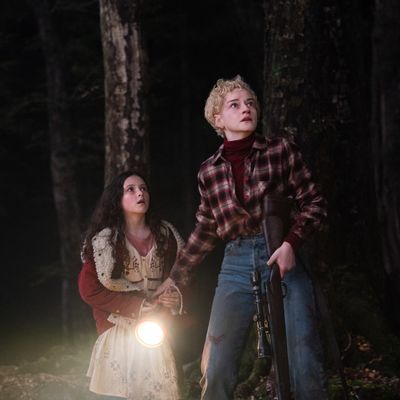
Wolf Man begins and ends with breathtaking images of a remote valley in central Oregon. A river rolls toward distant mountains covered in pines and gently wrapped by clouds in the kind of landscape that feels like it could be from a dream. Such a circular motif serves both to reassert a theme and to show, presumably, how much the characters have changed by the end of the film. “This place is beautiful, but also dangerous,” helpfully explains a local farmer and hunter (Sam Jaeger) to his young son, Blake, at the start. He talks about how people can be taken from you in an instant in this land. “It’s not hard to die,” he says. “It’s the easiest thing in the world.” Such fears, we quickly learn in the movie’s prologue, have turned the father into an authoritarian shell of a man, an intense and domineering survivalist who insists on military-style discipline from his son. That’s not just to stay clear of predators but also to guard against “Hills Fever,” an ominous animal-borne virus that the Indigenous people of this area call “the Face of the Wolf.”
Flash forward 30 years, and now Blake (Christopher Abbott) is an out-of-work writer living in the big city with his own family. He has a similar sense of anxiety about his young daughter, Ginger (Matilda Firth), though it has less to do with her straying in the paths of bears or ancient curses and more to do with her not listening to him as they walk down the street. The contrast between the man’s-man father (long missing and presumed dead) and the now-grown son is stark. Blake’s workaholic journalist wife, Charlotte (Julia Garner), is the main breadwinner in the family, striding into their apartment glued to her phone, refusing to end a work call even as Blake serves them dinner, and spending too little time with her daughter, who is often glued to Dad.
Wolf Man is a blunt movie, but it also feels like only half a movie. Returning to his deceased dad’s long-abandoned cabin for a brief stay, Blake brings Charlotte and Ginger along, and we sense very quickly that the old attitudes and the new attitudes will soon clash. But the film doesn’t really develop these ideas any further: One deadly swerve off the main road and the genre theatrics take over as Blake and his family are pursued by a barely glimpsed creature that sometimes seems like a woodland animal, sometimes a man. Blake comes in contact with the creature and starts changing. Now, a small spider’s steps sound in his head like drums; he starts to see in the dark; the words his wife and his daughter speak cease to have any meaning.
A veteran of the horror genre with some important films to his name (he wrote the Saw and Insidious movies and directed 2020’s The Invisible Man), Whannell knows how to put together a suspense set piece, and he delivers several creative ones here, making effective use of the textures and material of rural life. He fixes his camera on the steam rising from the breath of someone (or something) hiding on the other side of a hunting blind. He lets us bask in the agonizing tension of a slowly tearing plastic greenhouse roof. He builds anticipation for the delightful reveal of a grime-covered windshield being wiped for the first time in decades.
But these gnarly thrills are offset by impoverished characterizations. All that stuff in the film’s early scenes about Blake’s relationship with his dad, his daughter, and his wife wind up feeling like window dressing. The film, we sense, is trying to say something about how the sins of fathers get passed down to sons, but it eventually abandons the idea — almost as if it started off as a more ambitious project before genre demands derailed it. Abbott can be a wonderfully subtle actor, but Blake’s transformation doesn’t have any emotional weight, and the movie clearly wants it to, given how much time it spends with him. The Wolf Man is one of our lesser-served classic monsters, but he’s also one of the most charismatic when done right. At their best, werewolf pictures can be cathartic, romantic, tragic — a vision of our desires colluding with unchecked animal impulses. This Wolf Man, however, feels like a vague anecdote, devoid of human specificity.
It’s also, for a movie that opens with a lot of words about the entanglement of menace and beauty in nature, strangely murky for much of its final nocturnal act. The concern regarding overly dark cinematography in recent movies and TV may enter a new phase with the release of a picture whose climax plays out in such a muddy haze that I actually missed one jump scare entirely. This dim gloom is surely intentional: There are enough highlights in the frame, and Whannell contrasts the darkness with the Wolf Man’s ability to see through it, occasionally cutting to the creature’s infrared point of view. And, of course, horror thrives in the shadows. So it’s an artistic choice, and maybe audiences will go for the ride (though one wonders how the film will play on some of our more poorly lit screens), but given the undernourished plot and the cardboard characters, all that dimness might just reinforce the idea that, with this film, less is less.
More Movie Reviews
- The Accountant 2 Can Not Be Taken Seriously
- Another Simple Favor Is So Fun, Until It Gets So Dumb
- Errol Morris Has Been Sucked Into the Gaping Maw of True Crime


